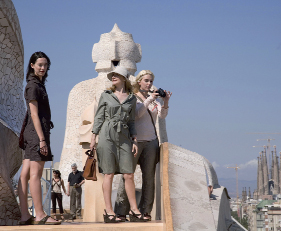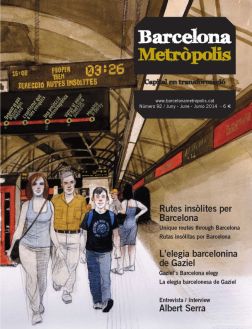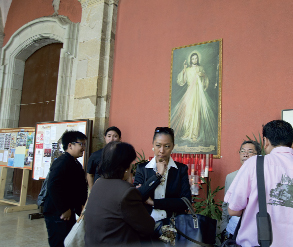One of the more curious sights you come across in Barcelona these days is that of a tourist curiously sniffing around a bicing stop. This is one of the few services the city offers that are forbidden to them. Like us, a tourist gets the metro, a bus or a taxi, but often, after looking in bewilderment at all those bikes lined up, they opt for one of the oldest things in the world: walking.
Accustomed as we are to rushing around on wheels, tourists can teach us to experience the city at a different pace, to see it from a different perspective. The gaze they cast over our streets and monuments is a reflection that shows us an image of what we are. It is also true that the memory of Barcelona they take away with them is largely linked to the traces and pointers we leave. We can indeed learn a lot from tourists, and one of these things is to start walking round the city again and paying attention to it.
Often we tend to think of tourists as gregarious little ants that only want to follow the usual routes round Gothic and Modernist Barcelona, but the reality is that lots of them are curious enough to lose themselves in the city, exploring neighbourhoods far from the centre and nooks and crannies that are hard to find in the guidebooks. And they discover marvels we no longer know how to appreciate.
For this issue of Barcelona Metròpolis we have asked nine authors to find us alternative and unusual routes round the city. The Barcelona of passageways and tunnels coexists with Masonic and Roman Barcelona. Decentralising tourism is not just a circulatory strategy, but one related to heritage, too.
In a letter written in 1903 to the editor of El Liberal, the writer Benito Pérez Galdós recalls his first stay here, in 1868, when Barcelona had already snapped “the belt of walls holding in the body of this historical city and was beginning to stretch its robust limbs, nourished by powerful blood”. Then, the sea and the mountains became Barcelona’s walls but today, paradoxically, the maritime highway has become the gateway for tourists and the mountains will be easier to cross once the Carretera de les Aigües has been turned into a huge green corridor. Barcelona Metròpolis invites you to break down some of the invisible walls that we have built round our fixed idea of Barcelona.

© Mediapro – Antena 3 Films / Gravier Productions / Àlbum
A scene of the film `Vicky, Cristina, Barcelona’ that takes place in La Pedrera.
Barcelona takes sixth position in the first world ranking of cities that have the best reputation or brand, according to the Guardian Cities Global Brand Survey, conducted by Saffron Brand Consultants, who have produced an index of the world’s 57 main cities. We must thank a lot of people for their efforts which have led to this recognition, but we must also honour it by living up to it and being faithful to what we are.
Not long ago, some art history students made an unusual discovery on Passeig de Gràcia: some council workers, who were retiling the pavement with Gaudí motifs, were not fitting the pieces of the mosaic together correctly. An insignificant incident yet a very encouraging one, because it gives us grounds for believing there are still citizens who are alert, keeping an eye on the integrity and authenticity of our cityscape. A city is alive if its relics are still alive.
If we limit ourselves to what predictable, easy, safe tourism gives us, we confine our visitors to banal truths, vulgar stereotypes, the traditional little postcard, in short, to a truism that ends up being false because it is so common. If, on the other hand, we showed them our hidden corners, revealed the secrets of our history, invited them into the city, which is our real home, that would be an exercise in altruism.




